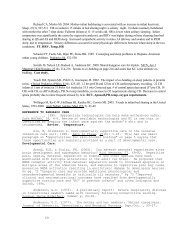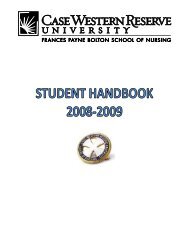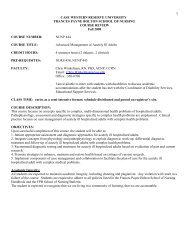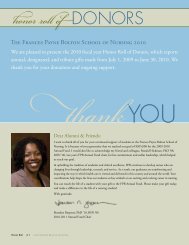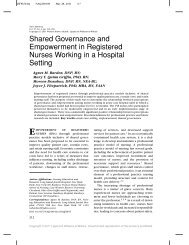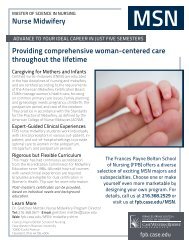Kangaroo Care BIBLIOGRAPHY Develope - Frances Payne Bolton ...
Kangaroo Care BIBLIOGRAPHY Develope - Frances Payne Bolton ...
Kangaroo Care BIBLIOGRAPHY Develope - Frances Payne Bolton ...
You also want an ePaper? Increase the reach of your titles
YUMPU automatically turns print PDFs into web optimized ePapers that Google loves.
Bergman, N.J. 1998. Making newborn care work.Child Health Dialogue, Issue 11, 2 nd quarter, p. 4. This<br />
document relates the role of KC in good care for all newborns. Clinical Report.<br />
Bergman, N. ???? <strong>Kangaroo</strong> mother care: Rediscover the natural way to care for newborn baby. International J<br />
of Childbirth Education 18 (1), 30 & 27. This is a simple to read reason why KC should be practiced with fullterm<br />
infants. Article conveys two concepts: No separation and Breastfeeding. Review, Full Term, BF<br />
Bergman, N. (2005). More than a cuddle: skin-to-skin contact is key. Practicing Midwife 8(9), 44. Short<br />
commentary on the importance of kangaroo care for breastfeeding and providing the natural niche for the infant. PT, FT,<br />
Commentary, Review..<br />
Bergman, N. (2006). <strong>Kangaroo</strong> mother care and skin-to-skin contact as determinants of breastfeeding success.<br />
Retrieved 1/20/2007 from www.Iwantmymum.com (http://www.iwantmymum.com/content/view/32/47). Clinical review<br />
of habitat and ecological niche of the infant and that KMC is really good for promoting breastfeeding. Says the biggest<br />
barrier to BF success is separation of mother and newborn. First part of article summarizes neurodevelopment of fetus<br />
and newborn, and second identifies barriers and how to fix them. Promotion of uninterrupted and continuous KC is<br />
needed. Does not have an actual measure of breastfeeding success (such as Carfoot’s desire and final study had), but is<br />
talking about overall success. This is very similar content to Winberg’s article<br />
Bergman NJ, Linley LL, & Fawcus SR 2004. Randomized controlled trial of skin-to-skin contact from birth<br />
versus conventional incubator for physiological stabilization in 1200- to 2199-gram newborns. Acta Paediatrica 93(6),<br />
779-785. Over first 6 hours post birth, gave either KC or incubator care and measured number of times infant’s<br />
physiologic values exceeded clinical norm range and scored the values using SCRIP, a stability scoring system.<br />
“Newborn care provided by KC on the mother’s chest results inm better physiological outcomes and stability than the<br />
same care provided in closed servo-controlled incubators. Cardiorespiratory instability seen in separated infants in the<br />
first 6 hrs is consistent with mammalian “protest-despair” biology, and with “hyperarousal & dissociation” response<br />
patterns described in human infants. Newborns should not be separated from their mothers.” (pg.779).PT, RCT, HR,<br />
RR, stabilization, birth KC , stability<br />
Bergman, N.J., & Jurisoo, L.A. (1994). The "kangaroo method" for treating low birth weight babies in a<br />
developing country. Tropical Doctor, 24, April 1994, 57-60 not.RCT, PT.<br />
Bergman N, Malan A, Hann M, Organizing Committee. (2003). Fourth International Workshop on <strong>Kangaroo</strong><br />
Mother <strong>Care</strong>. J. Tropical Pediatrics 49 (5), 311-312. Report of the 4 th Workshop is Cape Town in 2002. Reports that<br />
objectives of the workshop were to review clinical research, examine KMC public health policy, empower delegates to<br />
more effectively implement KMC, and equip delegates with ability to promote KMC to general public. KMC starting at<br />
birth with 1200 gramers and larger was shown to be safe (pg. 311),developmental and bonding benefits of KMC beyond<br />
12 months were shown, Cochrane (Anderson et al., 2003) of fullterm early KMC outcomes – BF outcomes most marked,<br />
less crying, improved attachment were reviewed. Many provinces and countries have adopted KMC as formal<br />
government policy, and WHO’s <strong>Kangaroo</strong> Mother <strong>Care</strong> – a Practical Guide was reviewed. Social marketing principles<br />
(selling KMC to the public) were presented on Day 3 by Dr. Amy Seidel Marks. Principles are: identify stake holders,<br />
package the message separately for each target audience or market sector, sometimes putting aside was the medical<br />
manager knows and whats for the community and instead putting in what the people’s needs and wants (the consumer’s<br />
perspective) are. Thus, KMC requires marketing not just a product,but new behaviours and values associated with<br />
KMC.Each segment of the market has a different value. Packaging must also match client’s stage of change. Barriers to<br />
change need to be understood and addressed for each market (readers are referred to Prochaska & DiClemente, 1983.<br />
Stages and processes of self-change of smoking: toward an integrative model of change. J. Consult Clin Psychol 51,390-<br />
395). Report, Birth KC, preterm birth KC, longitudinal KMC (AFTER 12 MONTHS), Fullterm, cry,<br />
attachment, BF, policy, implementation.<br />
Bergstrom A, Okong P, Ransjo-Arvidson AB. 2007. Immediate maternal thermal response to skin-to-skin care<br />
12




